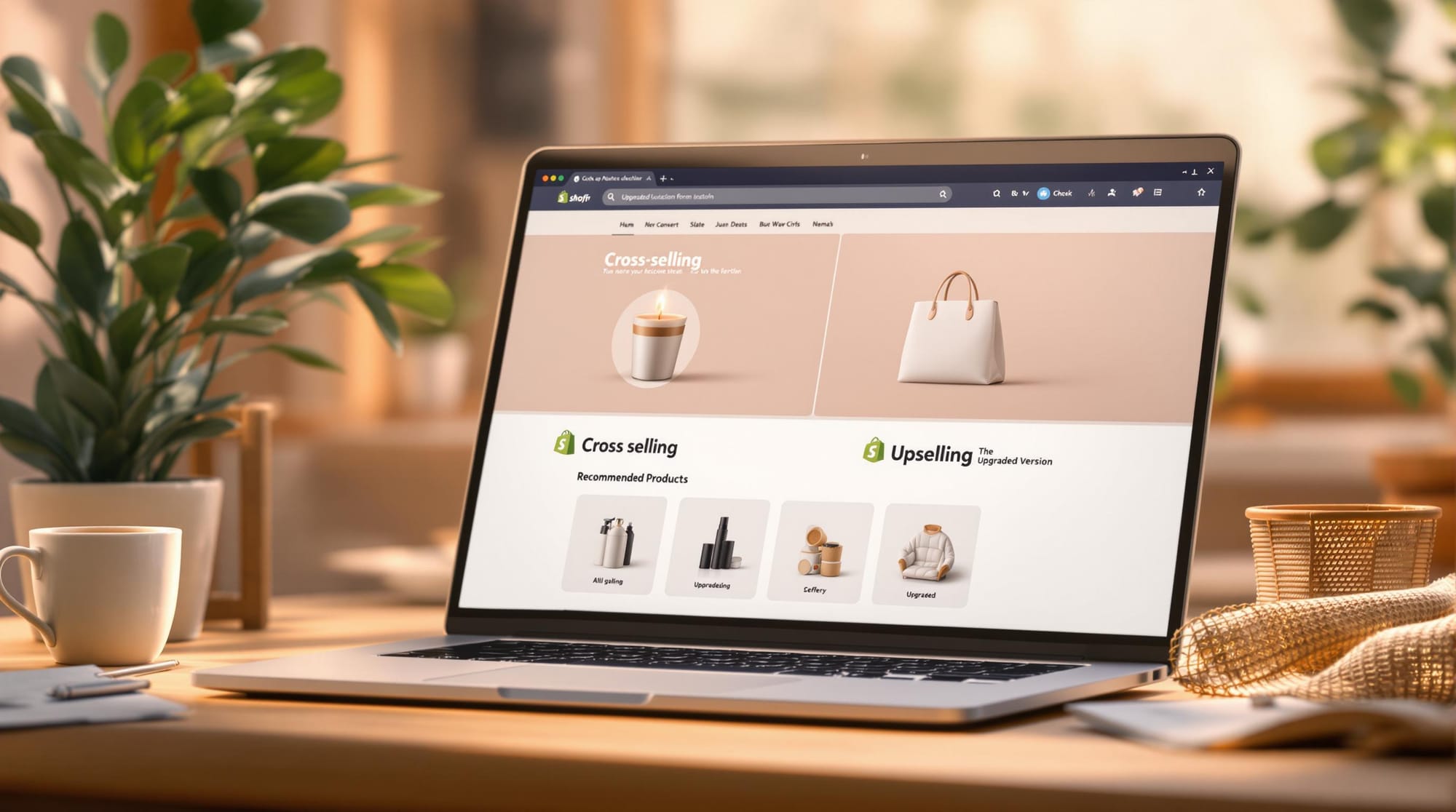Cross-Selling vs Upselling: Key Differences in Shopify
Learn the key differences between cross-selling and upselling on Shopify to boost your store's revenue and enhance customer experience.

Want to boost your Shopify store’s revenue? Cross-selling and upselling are two proven strategies that can help. Both aim to increase the average order value (AOV), but they work differently:
- Cross-Selling: Suggests complementary products (e.g., pairing a coffee maker with coffee beans and filters). Best used during checkout or post-purchase.
- Upselling: Promotes higher-end versions of a product (e.g., upgrading from a basic coffee maker to a premium model). Most effective on product pages or before checkout.
Quick Comparison
| Feature | Cross-Selling | Upselling |
|---|---|---|
| Purpose | Add related items to the cart | Upgrade to a better version |
| Example | Coffee maker + beans + filters | Basic coffee maker → Premium model |
| Best Timing | Checkout or post-purchase | Product page or pre-cart |
Why it matters: These strategies not only increase sales but also improve the shopping experience by offering personalized and relevant recommendations. Use AI tools, dynamic cart designs, and A/B testing to optimize results.
Shopify Upsell and Cross-sell Strategies | 2025 (with Real ...

Main Differences: Cross-Selling vs Upselling
Using cross-selling and upselling effectively can improve Shopify sales by focusing on either complementary items or premium upgrades.
When and Where to Use Each Method
Cross-Selling works best during checkout, in the cart drawer, or on the order confirmation page. For example, you might suggest related accessories like filters and coffee beans for a coffee maker.
Upselling, on the other hand, should happen earlier in the buying process. It’s most effective on product pages, during pre-cart selections, or even in search results when customers are still considering their options.
Now, let’s break down how the two methods connect with products.
How Products Connect
For cross-selling, the goal is to pair items that complement each other. Think of a coffee maker bundled with beans and filters.
Upselling focuses on encouraging customers to move to a higher-end version of the product. Here’s a quick comparison to illustrate:
| Feature | Basic Model | Premium Model |
|---|---|---|
| Capacity | 10 cups | 12 cups |
| Programming | Basic timer | Smart home integration |
| Warranty | 1 year | 3 years |
| Price | $79.99 | $149.99 |
Effects on Sales Value
On Shopify, these strategies can increase revenue in several ways:
- Add dynamic free shipping bars to encourage higher spend
- Use AI to personalize recommendations
- Optimize cart displays for mobile users
- Experiment with tiered pricing to appeal to different budgets
Both cross-selling and upselling can boost your average order value (AOV). Cross-selling encourages customers to add complementary products, while upselling increases the value of a single item. To get the best results, study customer behavior and tailor your approach to each product category.
Cross-Selling Methods for Shopify
Cross-selling is all about offering the right product combinations to increase order value and keep customers engaged.
Top Cross-Selling Methods
The best cross-selling strategies feel natural, adding value to the customer’s primary purchase.
- Bundle Recommendations: Group related products together. For example, pair a coffee maker with premium coffee beans, reusable filters, descaling solution, and a travel mug. These bundles make it easy for customers to see the value in buying more.
- Post-Purchase Suggestions: After a customer selects an item, show related add-ons in the cart drawer. This works especially well for consumable items or accessories they'll likely need soon.
- Usage-Based Pairings: Suggest items based on how they’re used, not just their category. For instance, if someone is shopping for winter boots, recommend winter socks, water-repellent spray, or boot care kits.
These approaches make recommendations feel personalized and relevant.
Product Suggestion Tips
Understanding how and when customers shop is crucial for effective cross-selling.
- Timing Is Key: Suggest products at the right moments - when items are added to the cart, during checkout, or even after the purchase is confirmed.
- Price Smartly: Keep suggested items reasonably priced compared to the main product. Customers are more likely to add smaller, affordable extras.
- Optimize for Mobile: Make sure cross-sell displays are mobile-friendly. They should load quickly, be easy to tap, and allow seamless cart additions.
Shopify Cross-Selling Tools
Shopify offers tools to make implementing these strategies easier:
- Dynamic Cart Design: Customize the cart drawer to highlight related products based on what’s already in the cart. A mobile-first approach ensures smooth functionality across devices.
- AI-Powered Recommendations: Use artificial intelligence to analyze customer behavior and suggest products that align with common purchase patterns. These recommendations adjust dynamically based on shopping activity.
- Discount Features: Entice customers with tiered discounts for bundles, bulk pricing for complementary items, dynamic free shipping thresholds, or personalized gift offers.
These tools can help you deliver tailored recommendations that feel seamless and encourage customers to buy more.
Upselling Methods for Shopify
Identifying Upsell Opportunities
To find the right upsell options, review your product catalog and pinpoint items with clear price and feature differences. Look for products that naturally lend themselves to upgrades or add-ons.
Here are some common categories for upselling:
- Basic vs. premium product versions
- Standard vs. extended warranties
- Regular vs. expedited shipping
- Single items vs. bundled packages
For example, if you sell kitchen appliances, you could offer a manual model, a programmable version, and an advanced automatic system. Each step-up should clearly showcase added benefits like better capacity, advanced features, or higher durability.
Once you’ve identified these premium options, the next step is presenting them in a way that resonates with your customers.
How to Make Upsells Work
To boost upsell success, focus on showing customers why the upgrade is worth it. The key is to make the added value obvious and relevant.
Here are some tips to create effective upsells:
- Use side-by-side feature comparisons to highlight differences.
- Stress long-term benefits like cost savings or improved quality.
- Include customer reviews that praise the premium product.
You can also use tools like free shipping bars to encourage larger purchases. For instance, a message like “Upgrade to the premium model and get free express shipping” can make the higher-priced option more appealing.
Shopify offers tools that make creating and managing these upsells easier.
Shopify Tools for Upselling
Modern upselling thrives on personalized, dynamic offers that catch customers’ attention at just the right moment. Shopify provides tools to help automate and improve this process, increasing your average order value.
Key features to look for include:
- AI-driven recommendations that adjust based on what’s in the cart
- Dynamic cart layouts that clearly display upgrade options
- Mobile-friendly designs to ensure upsells are easy to view and select
- A/B testing tools to refine pricing and promotional strategies
You can also add a personal touch to your upselling strategy. For example, when a customer adds a basic product to their cart, suggest a bundle that includes an accessory as a bonus. Tiered discounts, where the perks grow with higher spending, can also make premium options more enticing.
Tracking Results
Tracking your results is crucial for fine-tuning strategies and driving growth. The examples of increased Average Order Value (AOV) and reduced cart abandonment mentioned earlier highlight how monitoring can lead to measurable improvements.
Key Success Metrics
Keep an eye on these important metrics to evaluate your progress:
Average Order Value (AOV): This measures how much customers spend per order. A strong upselling strategy should gradually increase this number. For instance, if your starting AOV is $50, targeted upselling could raise it to $65 or more.
Conversion Rate: Check the percentage of customers who accept your cross-sell or upsell offers. Break this data down by:
- Product categories
- Timing of the offer (before checkout vs. after purchase)
- Device type (desktop vs. mobile)
Cart Abandonment Rate: Monitor how your strategies influence cart completion. A well-planned approach should lower the abandonment rate rather than discourage customers from completing their purchases.
Measuring Return on Investment
Evaluate the impact of your strategies with these indicators:
Revenue Growth: Compare sales before and after implementing new tactics. Look at:
- Total revenue increases
- Revenue per customer
- Profit margins on upsold products
Implementation Costs: Factor in the resources needed, such as:
- Ongoing maintenance
- Creating product bundles
- Testing and optimization efforts
These insights will help you identify what's working and where adjustments are needed.
Testing and Improvement
Refine your strategies through data-driven testing and adjustments:
A/B Testing Focus Areas:
- Progress bar designs to motivate higher spending
- Pricing models for bundled products
- Placement of upsell offers on your site
- Mobile-friendly layouts
Optimization Tips:
- Test one element at a time for at least two weeks to gather reliable data
- Experiment with dynamic pricing to find the best price points
- Analyze mobile performance separately for better insights
Combine customer feedback with metrics to get a complete view of how effective your strategies are and where to improve.
Conclusion
Key Takeaways
Here’s what you need to know about using upselling and cross-selling effectively:
- Boosting Revenue: Upselling increases order value, while cross-selling encourages customers to add more items to their cart, driving overall sales.
- Improving Customer Experience: Suggesting relevant products makes shopping more enjoyable and personalized.
- Versatile Application: You can use these techniques during browsing, at checkout, after purchase, and across multiple customer interactions.
Use these strategies to fine-tune your store and see the difference.
Steps to Get Started
Ready to apply these strategies to your Shopify store? Here’s how:
-
Analyze Your Data
Dive into your product data to pinpoint top sellers and logical upgrades. -
Define Your Goals
Set measurable targets like boosting average order value, increasing conversions, or cutting down cart abandonment. -
Start Small and Optimize
Begin with focused offers:- Suggest related products for your bestsellers.
- Highlight premium versions of popular items.
- Track results and fine-tune based on customer feedback.
